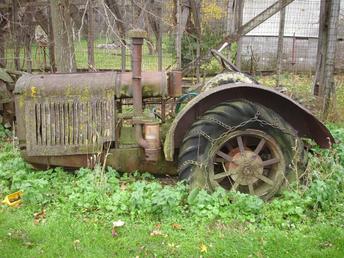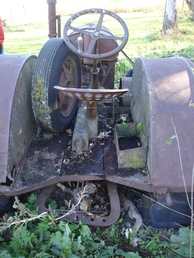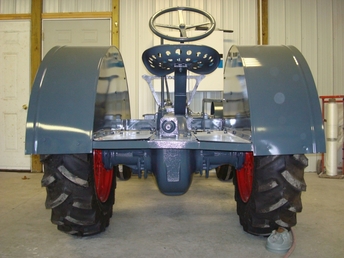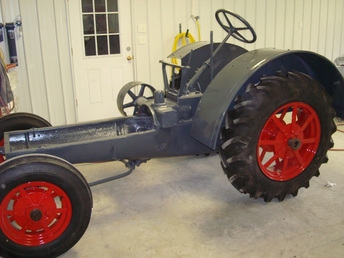Ah, what memories! I drove a 1929 10-20 for a good ten years, starting when I was about 10. I can recall everything about it, even what it felt like to pull up on the crank, hear the impulse click, the engine begin to bark when she started; the feel of that big gearshift, and the very hard steering. My father put rubber on the front only, but it didn't make it steer any better. In fact, it was worse in the field with a load. The steels had vertical "skid rings" to help pull the tractor around in a turn, and the rubber tires (off a small truck) had no skid-assist rings. A heavy load, like a disk harrow, tended to keep the tractor from turning, and since there were no wheel brakes the turns were made with considerable slewing forward, if the governor was wide-open. I eventually learned that if you slowed the tractor down to about half-throttle, the pull on the drawbar was lessened and the tractor would come right around.
For its day, this tractor had a pretty comfortable platform, and the controls were placed fairly well (except the governor/spark quadrants, which required a reach down under the steering wheel). Our '29 had a so-called muffler under the hood (with the exhaust coming out under the gas tank), but the engine had a pretty husky bark when it was loaded. This is a very large engine for a 2-plow tractor, so even though the h.p. isn't great, the torque is tremendous. It could not be stopped in second gear, no matter what the soil was like. It was also a great tractor to run a thresher or ensilage chopper on the belt. My father (and I) ran the '29 through about 1951, when he bought an H and left the faithful old one in a shed to disintegrate (it did; I wish I had cared more about it in 1951--it would have been an easy restoration--but at that point, it was just a rough-riding old tractor, and nobody gave much of a hoot about a 22-year old machine)(think about an '86 tractor now--who would get too excited about restoring it if it was replaced by something newer?).
I don't remember that ANY work was ever done on this tractor, other than, just maybe, replacement of points and spark plugs once in a while.
Another thought: For their day, the 15-30 (1921) and 10-20 (1923) were light-years ahead of the tractors they replaced. Compare a Titan 10-20 or an 8-16 and you'll see what I mean. On the newer tractors, everything is sealed to keep out dust and dirt; the engines are simple but smooth and extremely reliable, and they are not too difficult to drive. There are no chains driving the wheels, so you never had to worry about dirt wearing out the chains and sprockets.
There were other tractors that came out about the same time that were probably just as advanced, but you'll have to go back and take a look at what was available in the early 20s to make a comparison. I don't think IHC was ever very innovative, but what they did make was sturdy in the extreme.
IHC had a lock on tractors and machinery when I was growing up in NJ in the 30s and 40s, and I think it was because they had dealers about 15-20 miles apart. Until his dying day, my father thought 5 miles was "a trip," I guess because in his youth, 5 miles on a washboard road at 15 mph did seem like a trip. No wonder farmers were happy to be able to find IHC parts 5 or 6 miles away. The closest JD or Oliver dealers in my youth were about 20 miles away, and I am pretty sure that accounted for their lack of popularity in our neighborhood, even though those companies made good tractors and machinery.









